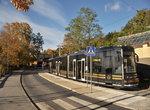Stockholm, Sweden Djurgården Line
![]()
Flexity Classic SL Class A34 no. 34 at Konsthallen on the Djurgården Line. Photo by David Pirmann, October 2010.
Overview
Tram line no. 7, the Djurgården line, has an interesting history. Nearly all of the tram lines in Stockholm ceased operation in 1967, when Sweden switched from drive-on-the-left to drive-on-the-right rule of the road, as in the rest of continental Europe. Single-ended tram vehicles were deemed too costly to replace or retrofit and most of Stockholm's tram operations were replaced by buses.
In 1991, the Djurgården line was resuscitated by enthusiasts, and a considerable fleet of elderly trams restored for use on the line. Starting in 1991, the line was operated with heritage trams by the Swedish Tramway Society. Djurgården is a popular destination for leisure activities, and features a small theme park amongst other attractions, and tram operation was confined mostly to the summer months, when the amusement attractions on Djurgården island are in full swing. Weekends-only operation was provided outside of the peak summer months of June through August; no service at all was provided from December through March. The tram service was operated from a downtown loop at Norrmalmstorg, on the edge of the CBD. The line proceeds eastward along Strandvågen in a reserved right-of-way, adjacent to the bustling waterfront, before turning right to cross a bridge onto the island of Djurgården. Here some of the track is of the conventional street running type.
In 2005, the line was absorbed into the operations of Stockholm transit group Storstockholms Lokaltrafik, and in 2008, construction began to extend the tram line from the terminus at Norrmalmstorg, along Hamngatan to Sergels Torg. In August 2010, the extended tram line no. 7 began daily, year-round operations from Sergels Torg to Waldermarsudde on Djurgården, using modern Bombardier Flexity Classic low-floor trams similar to those used in Stockholm's Tvärbanan and Nockebybanan light rail lines. The heritage trams operate mostly in the summer but can occasionally be found operating in the off months (e.g. October).
The Flexity Classic trams were manufactured by Bombardier in 2006, and there are six trams on the roster, numbered 33, 34, 35, 262, 263, 264. These trams were not built for Stockholm; 33-35 are borrowed from the Swedish city of Norrköping, and 262-264 are borrowed from Frankfurt, Germany. These trams are configured as follows: partially low-floor, 30m long, 2.4m wide, standard (1435mm) gauge, run on 750 VDC, and have room for 64 seated passengers. They have three sections (two articulation joints). There are some small differences; the easiest to spot is the color route number display present on the head ends of 33-35 and the single-color display on 262-264.
The present city terminus of the line is just short of Sergels Torg, on Hamngatan under the Malmskilinadgatan overpass. There are discussions taking place concerning extending the tram line to Central Station which is about 5 city blocks away from the present terminus. Other plans involve extending the line through the city to Ropsten (about 7 km).
Route Map

Map of Djurgården line from Wikipedia (Patrick Ekengren). Note that this map doesn't reflect the 2010 extension to Sergels Torg. (source and licensing - Creative Commons).
Photo Gallery
| Five Random Images | ||||
 Image 57089 (205k, 1024x788) Photo by: Herman R. Silbiger Location: Normalmstorg |  Image 57091 (216k, 1024x729) Photo by: Herman R. Silbiger Location: Normalmstorg |  Image 70471 (128k, 704x528) Photo by: Tim Deakin Location: Nybroplan |  Image 114096 (320k, 1044x701) Photo by: David Pirmann Location: Waldemarsudde |  Image 123080 (227k, 1044x595) Photo by: Bernard Chatreau Location: Normalmstorg |
Photos By Location
Photo locations: Sergels Torg, Kungsträdgården, Normalmstorg, Nybroplan, Styrmansgatan, Djurgårdsbron, Nordiska museet/Vasamuseet, Hazeliusporten, Konsthallen, Alkärrshallen depot, Gröna lund, Skansen, Waldemarsudde, Bellmansro
Links
Data page about the Flexity Classic, SL Class A34, from the Swedish Tramway Society.
The museum rolling stock of the Djurgården line from the Swedish Tramway Society.
Page Credits
By Tim Deakin and David Pirmann.